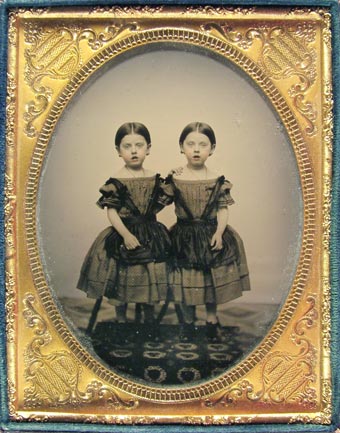- Inventor of Ambrotype and other important photographers
- The process is born from something first noted by Louis Désiré Blanquart-Evrard in 1850, when a slightly underexposed negatives image appears as a positive image against a dark background (Graphics Atlas).
- The name Ambrotype comes from James Ambrose Cutting who patented the method of adhering the cover glass and image-bearing support glass together with Canada balsam in 1854. Unfortunately, his method was unstable when it came to deterioration (Graphics Atlas).
- Interestingly, the name Ambrotype came before - Cutting changed his middle name in reference to the process. Ironically, it comes from the Greek word meaning "imperishable" (Graphics Atlas).
- Typical Ambrotypes
- Most ambrotypes are portraits. (Graphics Atlas).
- They can be found, similarly to daguerrotypes, in protective cases.
- Tips on how to identify and date examples
- The time frame for ambrotypes usually ranges around 1850 to almost the end of the 19th century. It was also used during the Civil War (A Primer on Process).
- The glass is flowed with a sticky material known as iodized collodion. It is then sensitized by being dipped into a bath of silver nitrate, and exposed in the camera while still wet. A chemical developer is used to bring out the image (A Primer on Process).
- Ambrotypes can be confused with daguerrotypes and tintypes upon first glance, but are not reflective like their daguerrotype predecessor, and are not magnetic like a metallic tintype.
- The image is normal or reversed according to which side lays against the black backing of the case (edinphoto.org.uk)
- "Ambrotypes were often produced using one-eighth of a wholeplate (6.25" x 8.5") sheet of glass. This gave images about 3.125" x 2.125" (edinphoto.org.uk)
- Again, ambrotypes are mounted in ornate protective cases. Sometimes the glass was tinted or hand painted in order to give more detail to the photo, especially the coloring of cheeks, jewelry, and clothing.
- Preservation concerns
- Unfortunately, ambrotypes are not as imperishable as their namesake had hoped. A common pitfall is the breaking and lifting of the varnish used to back the image. This is known as "reticulation" and is often caused by the deterioration of the glass used (Graphics Atlas).
- High levels of humidity and temperature are detrimental for these photos and cause reticulation (Graphics Atlas).
- Small cracks or yellow droplets on the glass ("weeping glass" - caused by humid environments) tend to appear on ambrotypes that were not stored properly.
- References
- Graphics Atlas. Ambrotype. graphicsatlas.org
- A Primer on Process. photographymuseum.com/primer.html
- Edin Photo. Ambrotype or Colldion positives. edinphoto.org.uk
 |
| http://brightbytes.com/collection/ambrotypes.html |
No comments:
Post a Comment